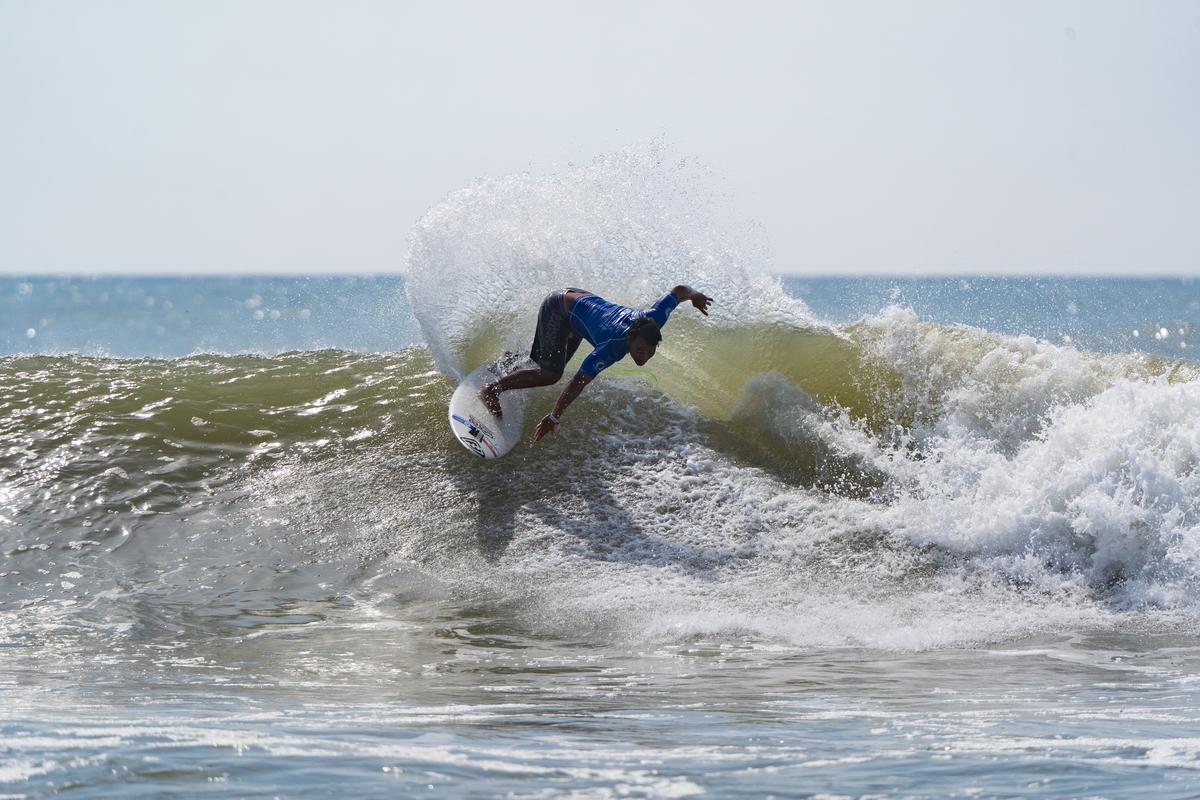Indonesia, a paradise for visiting surfers with a wave for every style, has become the powerhouse of competitive surfing in Asia.
In 2024, it secured a double-quota at the Asian Games and a Men’s Open title at the Asian Surfing Championships (ASC), backed by impressive results from the women’s team.
That dominance carried into 2025, at the ASC in Mahabalipuram. The nation’s depth was on full display: two Indonesians battled for the Men’s Open crown, with one making the podium, while the women’s solid points haul all but guaranteed two more Asian Games slots.

The Indonesia surfing team at the 2025 Asian Surfing Championships in Mahabalipuram, Chennai.
| Photo Credit:
Special Arrangement
The Indonesia surfing team at the 2025 Asian Surfing Championships in Mahabalipuram, Chennai.
| Photo Credit:
Special Arrangement
It’s a standard that India’s surfers admire and aspire to match.
“In India, we don’t have good waves all the time. If you go to Indonesia, they have great waves every day, all the facilities, and sponsors,” said Ramesh Budihal, India’s first individual medallist at the continental level.
The Indian surfer, who has twice trained in Bali, beat one of Indonesia’s stars, Mega Artana, to clinch bronze in a fiercely contested final, while defending champion Pajar Ariyana bagged silver. “They train every day. They compete every month. That’s what we need in India,” Budihal added.
Indonesia’s edge
For decades, Indonesia’s abundant and consistent surf — from Bali’s famed reef breaks to the remote Mentawais — has been a training ground unlike any other in Asia. Local surfers grow up riding powerful, technical waves year-round, competing in regular domestic and regional contests, and benefiting from a growing support network.
“In Indonesia, surfing was established 35 or 40 years ago. All the surfers from around the world tried to find a new place, and they found Indonesia to be the dream escape,” Dylan Amartha, Indonesia’s national coach, tells Sportstar.
“The locals started to watch and learn from the tourists, and soon, they began to surf.”
ALSO READ: Ramesh Budihal wins historic bronze at Asian Surfing Championships
But that culture didn’t come without barriers.
“Initially, they were really afraid to go into the ocean. There was this age-old myth — the sea god will punish those who spend too much time in the water,” Amartha explains. “But this generation is breaking those shackles. Everyone has realised what the sport has to offer.”
“All the surfers from around the world tried to find a new place, and they found Indonesia to be the dream escape,” Dylan Amartha, Indonesia’s national coach, tells Sportstar.
| Photo Credit:
A. Siva Sankar/Sportstar
“All the surfers from around the world tried to find a new place, and they found Indonesia to be the dream escape,” Dylan Amartha, Indonesia’s national coach, tells Sportstar.
| Photo Credit:
A. Siva Sankar/Sportstar
That same environment has turned Indonesia into a classroom for the region.
Surfers from across Asia — from India and the Maldives to China and Thailand — now spend weeks or months in Indonesia, training alongside locals, and experiencing consistent swell.
With more international surfers training in their waters, Indonesians face a new reality: others are gaining the advantage of training like the local pros.
But Amartha believes this dynamic has its upsides and downsides. “The advantage is that we get to see all levels of the world’s surfers, the standards of competitions, and their techniques.
“The other side is that it gets really hard to find waves, but it is something that we are used to,” he says. “But we learn a lot from the other surfers. The kids also pick new things from them and use them to better themselves.”
Riding the global wave
Indonesia’s rise hasn’t stopped at the Asian level. Its surfers have steadily gained ground internationally, where athletes like Rio Waida have become household names.
He made history as the first Indonesian to qualify for surfing’s Olympic debut at Tokyo 2020 and returned for Paris 2024, boosting the sport’s visibility at home.
For Amartha, Olympic qualification was a turning point for the sport in Indonesia. “After the Olympics, it changed everything. More kids wanted to start surfing.
While most were from places near the ocean, we had many coming from the city, who moved to the coast just to surf,” he says.
Indonesia’s strong foundation and coaching expertise have translated into consistent success on both the Asian and international stages. Yet the growing talent pool across Asia is starting to challenge Indonesia’s dominance — most recently, the Indian contingent.

Surfers from across Asia — from India and the Maldives to China and Thailand — now spend weeks or months in Indonesia, training alongside locals, and experiencing consistent swell.
| Photo Credit:
Special Arrangement
Surfers from across Asia — from India and the Maldives to China and Thailand — now spend weeks or months in Indonesia, training alongside locals, and experiencing consistent swell.
| Photo Credit:
Special Arrangement
Amartha sees India’s progress as promising, but stresses that talent alone is not enough. “They’ve improved a lot — I told that to all the teams. They are on a really good path. But they need more backing from the federation, companies, and government.
“That’s what we get from Indo. We have everyone supporting the team. That’s how everything is going to grow,” he notes.
Amartha remains optimistic about the future of surfing in Asia. “This is a good training ground to create stars for the future. I hope to see more Indian surfers on the world stage. That’s a good sign for Asia.”
“In Indonesia, we believe growth comes from lifting others with respect,” Amartha adds.
With Indonesia’s established strength and India’s rapid progress, the two nations are set to push each other harder to elevate the level of competition at the Asian Games and beyond — a positive sign for the future of surfing in Asia.